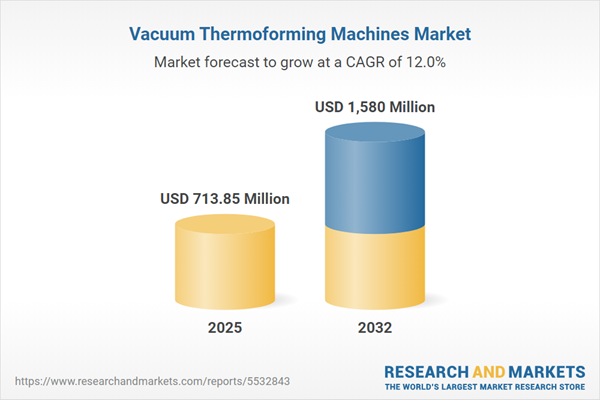Speak directly to the analyst to clarify any post sales queries you may have.
Senior executives overseeing procurement in the vacuum thermoforming machines market encounter a dynamic environment marked by innovation, regulatory shifts, and the ongoing imperative to strengthen global supply chains. Strategic market intelligence equips organizations to adapt sourcing, maintain resilience, and capture new opportunities in this evolving sector.
Market Snapshot: Vacuum Thermoforming Machines Market
In 2024, the global vacuum thermoforming machines market was valued at USD 636.93 million and is projected to reach USD 713.85 million by 2025 and USD 1.58 billion by 2032. This anticipated growth, representing a 12.04% CAGR, is fuelled by sustained demand from industries including automotive, food packaging, medical devices, and consumer electronics. For these sectors, consistent machine performance and regulatory compliance remain procurement priorities. Advances in automation and materials science are driving gains in productivity and flexibility, challenging supply chain leaders to continually align with increasingly stringent regulatory and sustainability frameworks.
Scope & Segmentation in the Vacuum Thermoforming Machines Market
This report delivers a comprehensive assessment of pivotal segments shaping procurement and investment decisions. The detailed segmentation guides senior decision-makers in building responsive and compliant operations across diverse regions and industries.
- Plastic Materials: Choices such as Acrylonitrile Butadiene Styrene (ABS), Polyethylene Terephthalate (PET), Polystyrene (PS), and Polyvinyl Chloride (PVC) allow cross-sector adaptability, while supporting compliance and technical requirements.
- Machine Types: Roll fed machines offer high-volume, continuous production capability; sheet fed models provide flexibility suited for customized and lower-scale manufacturing needs.
- Operation Modes: Fully automatic setups drive efficiency and reduce manual handling; semi-automatic models deliver versatility; manual machines are best for specialized or precision-focused production environments.
- Sheet Thickness Categories: Equipment accommodates a range of sheet gauges, from materials used in lightweight packaging applications to those required for heavy-duty industrial use cases.
- Application Industries: Key user segments include automotive, food packaging, medical devices, and electronics, each demanding reliable and standards-compliant production with tailored process options.
- Regional Coverage: The Americas, Europe, Middle East & Africa, and Asia-Pacific present distinct supplier networks, regulatory standards, and technology adoption rates influencing supply chain strategies in each region.
- Key Industry Participants: Notable suppliers and technology leaders influencing market direction include Illig Maschinenbau GmbH & Co. KG, Brown Machine Group, Inc., Kiefel GmbH, GN Thermoforming Solutions GmbH, SencorpWhite, LLC, PlastiForm Technologies Ltd, Lee Industrial, Inc., Thermoforming Technologies, Inc., Formech UK Ltd, and Zed Industries Limited.
Key Takeaways for Executive Decision-Makers
- Expanding material and product portfolios helps address regulatory variation, diverse application needs, and evolving customer requirements across international markets.
- Integrating Industry 4.0 technologies, like advanced automation and real-time analytics, supports higher asset utilization, drives efficiency, and streamlines equipment adaptation across production sites.
- Pursuing recycled and bio-based plastic options positions organizations to satisfy environmental mandates and enhance sustainable procurement practices.
- Geographic factors shape procurement focus: North American buyers emphasize aftersales support and local sourcing; European firms target regulatory alignment and sustainability; Asia-Pacific customers prioritize scalability and modular solutions.
- Robust supply chains, adaptable tooling, and flexible layouts provide operational stability and facilitate process adjustments as requirements shift.
Tariff Impact on Market Structure
Planned changes to U.S. tariffs in 2025 are prompting businesses to review sourcing and cost structures. Larger companies are increasingly sourcing domestically or assembling locally to manage exposure to trade policy changes, while smaller firms gain leverage through collective purchasing strategies. Extending equipment lifespans and tailoring maintenance approaches to business scale further help control costs and manage risk.
Methodology & Data Sources
This analysis is based on direct interviews with leading manufacturers, suppliers, and end users in the vacuum thermoforming machines market. All findings are corroborated through systematic secondary research and reviewed for compliance with recognized regulatory standards.
Why This Report Matters
- Supports executive alignment of procurement and technology strategies with changing regulatory, environmental, and organizational goals.
- Delivers actionable segmentation, informing capital allocation, market entry, and process optimization across industries and regions.
- Provides robust benchmarking by detailing technical and operational standards central to leading supplier and manufacturing practices.
Conclusion
Executives can apply these insights to sharpen investment decisions, build adaptive operations, and guide long-term growth initiatives in the vacuum thermoforming machines market.
Additional Product Information:
- Purchase of this report includes 1 year online access with quarterly updates.
- This report can be updated on request. Please contact our Customer Experience team using the Ask a Question widget on our website.
Table of Contents
3. Executive Summary
4. Market Overview
7. Cumulative Impact of Artificial Intelligence 2025
Companies Mentioned
The companies profiled in this Vacuum Thermoforming Machines market report include:- Illig Maschinenbau GmbH & Co. KG
- Brown Machine Group, Inc.
- Kiefel GmbH
- GN Thermoforming Solutions GmbH
- SencorpWhite, LLC
- PlastiForm Technologies Ltd
- Lee Industrial, Inc.
- Thermoforming Technologies, Inc.
- Formech UK Ltd
- Zed Industries Limited
Table Information
| Report Attribute | Details |
|---|---|
| No. of Pages | 181 |
| Published | October 2025 |
| Forecast Period | 2025 - 2032 |
| Estimated Market Value ( USD | $ 713.85 Million |
| Forecasted Market Value ( USD | $ 1580 Million |
| Compound Annual Growth Rate | 12.0% |
| Regions Covered | Global |
| No. of Companies Mentioned | 11 |









